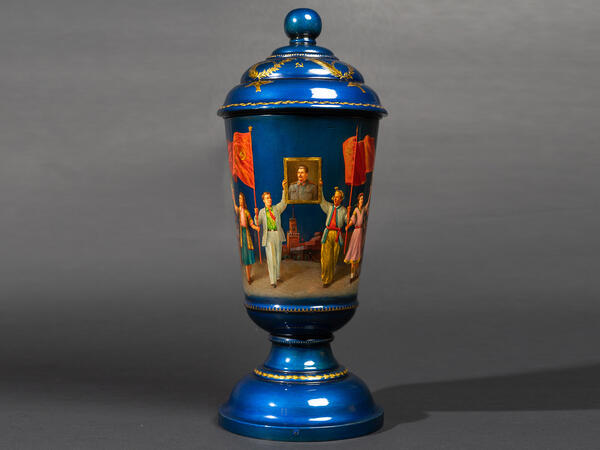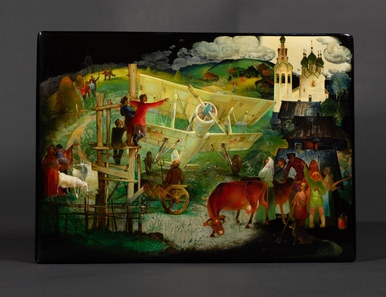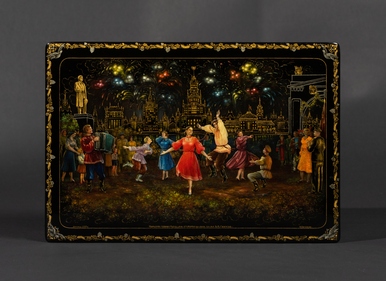Mikhail Pashinin is an Honored Artist of the Russian Soviet Federative Socialist Republic, one of the leading masters of Fedoskino miniature. He was born on August 23, 1921. The master participated in the Great Patriotic War and was awarded the medals ‘For the victory over Germany’ and ‘For the victory over Japan’. From 1971 to 1975, he taught at the Fedoskino School of Miniature Painting.
The author’s legacy numbers more than 300 lacquer miniature paintings. His portraits were especially popular: he portrayed the top state officials, Russian poets and writers.
In the post-war 1950s, artists often turned to the theme of peaceful life and faith in a happy future; their works were replete with joy, hope and sincere confidence in tomorrow. The theme of the cup “For Lasting Peace” is friendship of peoples. On its geometric surfaces, the artist depicted a plethora of representatives of different countries and nations. He did not choose this particular subject matter on accident: as a war veteran, he felt especially strongly the need of the peoples to live in peace.
Moscow’s Red Square is depicted in the background: young people walk along the cobblestones with the Spasskaya Tower of Moscow Kremlin and Vladimir Lenin’s Mausoleum behind them. The composition resembles a peaceful demonstration, and the characters echo images from Soviet posters.
Mikhail Pashinin captured young people — representatives of the Soviet and Chinese republics. Together they carry a portrait of Joseph Stalin, and the national flags of their countries. The choice of this subject matter was probably connected with a significant event in the history of the Soviet Union: on February 14th, 1950, the Sino-Soviet Treaty of Friendship, Alliance and Mutual Assistance was signed. The agreement entered into force on April 11th of the same year and was valid for exactly 30 years.
Along with the young men, women also actively participate in the march. It was important for the master to emphasize that the Friendship Treaty concerns every person and was intended for the younger generation. That is why one can see slogans on the miniature, such as “Peace to the World!” and “Youth, Unite! Forward for Lasting Peace!”
This work of Mikhail Pashinin conveys the enthusiasm of young people; each demonstrator has their own character and mood. In general, the painting speaks not only to the great skill of the artist, but also to his vast experience in creating such subjects.
The author’s legacy numbers more than 300 lacquer miniature paintings. His portraits were especially popular: he portrayed the top state officials, Russian poets and writers.
In the post-war 1950s, artists often turned to the theme of peaceful life and faith in a happy future; their works were replete with joy, hope and sincere confidence in tomorrow. The theme of the cup “For Lasting Peace” is friendship of peoples. On its geometric surfaces, the artist depicted a plethora of representatives of different countries and nations. He did not choose this particular subject matter on accident: as a war veteran, he felt especially strongly the need of the peoples to live in peace.
Moscow’s Red Square is depicted in the background: young people walk along the cobblestones with the Spasskaya Tower of Moscow Kremlin and Vladimir Lenin’s Mausoleum behind them. The composition resembles a peaceful demonstration, and the characters echo images from Soviet posters.
Mikhail Pashinin captured young people — representatives of the Soviet and Chinese republics. Together they carry a portrait of Joseph Stalin, and the national flags of their countries. The choice of this subject matter was probably connected with a significant event in the history of the Soviet Union: on February 14th, 1950, the Sino-Soviet Treaty of Friendship, Alliance and Mutual Assistance was signed. The agreement entered into force on April 11th of the same year and was valid for exactly 30 years.
Along with the young men, women also actively participate in the march. It was important for the master to emphasize that the Friendship Treaty concerns every person and was intended for the younger generation. That is why one can see slogans on the miniature, such as “Peace to the World!” and “Youth, Unite! Forward for Lasting Peace!”
This work of Mikhail Pashinin conveys the enthusiasm of young people; each demonstrator has their own character and mood. In general, the painting speaks not only to the great skill of the artist, but also to his vast experience in creating such subjects.



